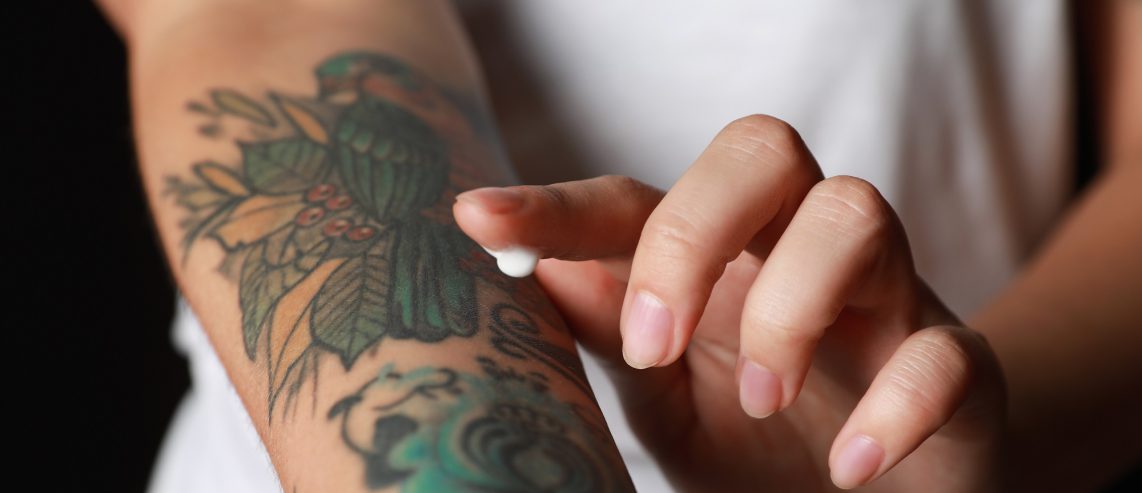An infected tattoo can be scary and upsetting. Tattoos can be pricey, and once you go through the pain of getting inked, you want to show off the result. Infected tattoos can not only be unsightly, but they can also be dangerous to your health.
See a doctor if your tattoo becomes red or inflamed beyond what’s typical in the healing process. They can determine whether your symptoms are due to an infection or an allergic reaction. Getting prompt treatment for an infected tattoo is vital to ensure it doesn’t spread.
Is My Tattoo Infected?
When your tattoo artist injects ink into your skin, your immune system floods antibodies to the area. This reaction is normal and leads to swelling and redness. In the first two weeks, it’s also normal to have itching, flaking, oozing clear liquid, and scabbing.
But if it’s been over two weeks, and your symptoms are getting worse rather than better, you might have an infected tattoo.
Be on the lookout for these signs of an infected tattoo:
- Redness that gets worse and spreads after the first week.
- Pain at the site that worsens after the first week.
- Pus (thick yellowish or greenish discharge).
- Itchiness that gets worse.
- Bumps in the tattoo.
- A fever.
- Chills and sweating.
The signs of infection usually appear in the first days and weeks of getting a tattoo. However, an infection can occur anytime in the first few months.
If you experience signs or symptoms that could be an infected tattoo, see a doctor.
Never Miss a Beat!
Subscribe to Our HealthBeat Newsletter!
Thank you for subscribing!
You can now select the specific newsletters you'd like to receive.
You are already subscribed.
Subscribe to more newsletters in our email preference center.
Sorry, an error occurred. Please try again later.
Get Healthy Tips Sent to Your Phone!
Is it an Infected Tattoo or an Allergic Reaction?
It can be tough to tell the difference between an infected tattoo and an allergic reaction, as they have similar symptoms. An allergic reaction can happen immediately, within the first few months, or even years later.
In other words, if redness and bumps are happening in a tattoo that’s years old, that’s an allergic reaction, not an infection. Sometimes a medical treatment, like a joint-replacement surgery, can trigger the immune system to react to old tattoo ink. Other times, an allergic reaction to a tattoo can seem to come out of nowhere.
Symptoms of an allergic reaction include:
- Swelling.
- Redness.
- Itchiness.
- Blisters or lumps on the skin.
- Small bumps on the skin.
- A watery fluid.
- Scaly skin.
You can treat an allergic reaction that only affects the tattoo site and not the rest of the body at home. If the itchiness or swelling bothers you, take over-the-counter anti-allergy medicines.
If the signs of an allergic reaction don’t go away after a couple of weeks, see a doctor for help. And if you have any of the signs of a severe allergic reaction, call 911 or go to the emergency department:
- Trouble breathing.
- Redness or hives that spread on the face or body.
- Extreme swelling.
- A fast heartbeat.
- Chest tightness.
- Dizziness.
- Stomach pains.
What Causes an Infected Tattoo?
Tattoos can cause an infection if the needle or ink contains bacteria or if the artist mixes the ink with bacteria-containing water. If the tattoo artist reuses a needle, this can also spread a viral infection from one person to the next. Hepatitis B, Hepatitis C, and HIV infections have spread through unsafe tattoo practices.
Most professional tattooing studios use single-use sterile equipment, so infections are typically linked to tattoo ink. The ink may come from a factory with unsterile conditions, for example.
What is the Treatment for an Infected Tattoo?
If you have an infected tattoo, your doctor will prescribe antibiotics. In most cases, doctors prescribe oral antibiotics. They may prescribe IV antibiotics for a serious infection.
It is crucial to take antibiotics as often as prescribed, as long as your doctor recommends them. If you miss doses or stop too early, your infection can persist or come back.
If antibiotics don’t work to clear up the infection, your doctor will take a skin sample to determine the bacteria present. Your doctor may need to prescribe a special antibiotic if you have a rare bacterial infection.
How to Avoid an Infected Tattoo
To avoid an infected tattoo, pay attention to the studios’ cleanliness and sterile process. Choose a studio fully licensed by your state authority. Visit the studio — don’t go ahead with a tattoo if it doesn’t look very clean to you.
Ask about their infection control processes. The artist should be able to describe their methods in detail. If they don’t, that’s a red flag.
The tattoo artist should use a new single-use, sterile needle and new disposable tubes and ink cups. The artist should open this equipment in front of you.
Check that the tattoo artist washes their hands and uses new disposable gloves for the process. If the artist has to touch something unsterile, like a phone, they should clean their hands again and wear new gloves.
The tattoo artist should clean your skin with an antiseptic solution. They should never use non-sterile water from the tap to wipe the skin or dilute the ink. Ensure the professional only uses new, packaged water with ‘sterile’ on the label.
Check the Food and Drug Administration’s website for tattoo ink recalls. Make sure the artist is not using any ink the FDA has recalled due to contamination. Make sure the tattoo artist shouldn’t reuse ink by pouring excess ink back into the bottle.
Sources
American Academy of Dermatology Association. Tattoos: 7 unexpected skin reactions and what to do about them. Link
Food and Drug Administration. FDA advises consumers, tattoo artists, and retailers to avoid using or selling certain tattoo inks contaminated with microorganisms. Link
Food and Drug Administration. Tattoos and permanent makeup: Fact sheet. Link
Marci Robin. What to do if your new tattoo gets infected. Good Housekeeping. Link
About UPMC
Headquartered in Pittsburgh, UPMC is a world-renowned health care provider and insurer. We operate 40 hospitals and 800 doctors’ offices and outpatient centers, with locations throughout Pennsylvania, Maryland, New York, West Virginia, and internationally. We employ 4,900 physicians, and we are leaders in clinical care, groundbreaking research, and treatment breakthroughs. U.S. News & World Report consistently ranks UPMC Presbyterian Shadyside as one of the nation’s best hospitals in many specialties and ranks UPMC Children’s Hospital of Pittsburgh on its Honor Roll of America’s Best Children’s Hospitals. We are dedicated to providing Life Changing Medicine to our communities.

